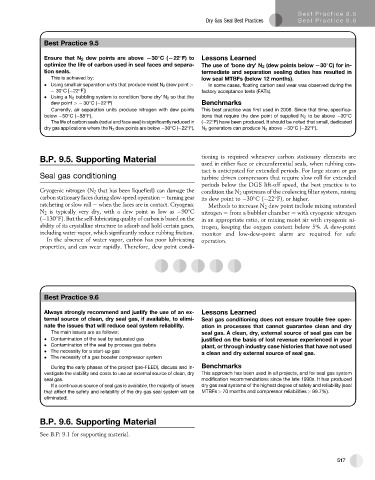Page 546 - Subyek Teknik Mesin - Forsthoffers Best Practice Handbook for Rotating Machinery by William E Forsthoffer
P. 546
Be st Practice 9.5
Dry Gas Seal Best Practices Be st Practice 9.6
Best
Best Practice 9.5Practice 9.5
Ensure that N 2 dew points are above L30 C(L22 F) to Lessons Learned
optimize the life of carbon used in seal faces and separa- The use of ‘bone dry’ N 2 (dew points below L30 C) for in-
tion seals. termediate and separation sealing duties has resulted in
This is achieved by: low seal MTBFs (below 12 months).
Using small air separation units that produce moist N 2 (dew point > In some cases, floating carbon seal wear was observed during the
30 C[ 22 F]) factory acceptance tests (FATs).
Using a N 2 bubbling system to condition ‘bone dry’ N 2 so that the
dew point > 30 C( 22 F) Benchmarks
Currently, air separation units produce nitrogen with dew points This best practice was first used in 2008. Since that time, specifica-
below 50 C( 58 F). tions that require the dew point of supplied N 2 to be above 30 C
The life of carbon seals (radial and face seal) is significantly reduced in ( 22 F) have been produced. It should be noted that small, dedicated
dry gas applications where the N 2 dew points are below 30 C( 22 F). N 2 generators can produce N 2 above 30 C( 22 F).
B.P. 9.5. Supporting Material tioning is required whenever carbon stationary elements are
used in either face or circumferential seals, when rubbing con-
tact is anticipated for extended periods. For large steam or gas
Seal gas conditioning turbine driven compressors that require slow roll for extended
periods below the DGS lift-off speed, the best practice is to
Cryogenic nitrogen (N 2 that has been liquefied) can damage the condition the N 2 upstream of the coalescing filter system, raising
carbon stationary faces during slow-speed operation e turning gear its dew point to 30 C( 22 F), or higher.
ratcheting or slow roll e when the faces are in contact. Cryogenic Methods to increase N 2 dew point include mixing saturated
N 2 is typicallyverydry,withadewpoint as lowas 90 C nitrogen e from a bubbler chamber e with cryogenic nitrogen
( 130 F). But the self-lubricating quality of carbon is based on the in an appropriate ratio, or mixing moist air with cryogenic ni-
ability of its crystalline structure to adsorb and hold certain gases, trogen, keeping the oxygen content below 5%. A dew-point
including water vapor, which significantly reduce rubbing friction. monitor and low-dew-point alarm are required for safe
In the absence of water vapor, carbon has poor lubricating operation.
properties, and can wear rapidly. Therefore, dew point condi-
Best
Best Practice 9.6Practice 9.6Practice 9.6Practice 9.6Practice 9.6
Best
Best
Best
Always strongly recommend and justify the use of an ex- Lessons Learned
ternal source of clean, dry seal gas, if available, to elimi- Seal gas conditioning does not ensure trouble free oper-
nate the issues that will reduce seal system reliability. ation in processes that cannot guarantee clean and dry
The main issues are as follows: seal gas. A clean, dry, external source of seal gas can be
Contamination of the seal by saturated gas justified on the basis of lost revenue experienced in your
Contamination of the seal by process gas debris plant, or through industry case histories that have not used
The necessity for a start-up gas a clean and dry external source of seal gas.
The necessity of a gas booster compressor system
During the early phases of the project (pre-FEED), discuss and in- Benchmarks
vestigate the viability and costs to use an external source of clean, dry This approach has been used in all projects, and for seal gas system
seal gas. modification recommendations since the late 1990s. It has produced
If a continuous source of seal gas is available, the majority of issues dry gas seal systems of the highest degree of safety and reliability (seal
that affect the safety and reliability of the dry gas seal system will be MTBFs > 70 months and compressor reliabilities > 99.7%).
eliminated!
B.P. 9.6. Supporting Material
See B.P: 9.1 for supporting material.
517

